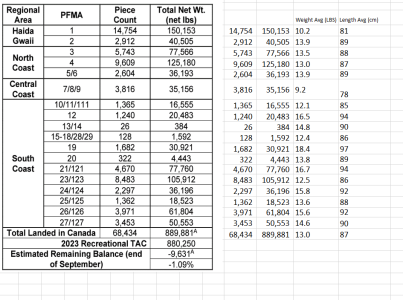Lots of questions about why. Answering those is about as complicated as the data analysis the SFAB and DFO employ to determine regulations choices....so, for what it is, here is a long winded explanation.
I was directly involved on the team engaged to review our options against the available TAC, and attended the IPHC as part of the Canadian Conference Board delegation. As noted there were several issues we had to consider. First, the IPHC set line survey data (and science advice) demonstrated that the biomass is dominated by 1 age class (2012 spawning cohort), and the larger, older fish are aging out of the fishery. Set line data confirmed smaller sizes encountered and not a lot of evidence to suggest there are more younger age class recruits coming up in the biomass. Also troubling is the trend this is lowest biomass in 30 years. The spawning biomass is currently estimated to be at 42 percent of its unfished state, near the lowest level observed since the 1970s.
Against that data, the IPHC decided to reduce the coast wide TAC resulting in the BC recreational allocation decreasing by the 4.57% reduction agreed to by IPHC. On top of that, the recreational fishery caught more fish last season than our TAC. Initially it was thought to be 9,800 lbs, but upon further analysis of data (late catch logs etc), it was determined that the Rec fishery was actually 30,000+ lbs over last season. This overage was deducted from the already reduced 2024 TAC. To frame the impact, 30,000 lbs is on average the total TAC the recreational fishery uses between February to April or sometimes early May each season.
We completed a detailed analysis of new data that came available only this season from the iREC survey. The survey was changed to ask respondents to look at their license to provide the actual size in cm recorded on their license for all halibut. This was/is an amazing tool because for the first time ever, that allowed me to run an analysis breaking down the numbers of halibut reported for each cm size of reported catch. That analysis demonstrated that the vast majority of the 2023 catch actually was fish under 90cm. This should not be surprising, because the data indicates the biomass is now dominated by smaller, younger fish.
Brief Summary of the data results from iREC:
The 2023 IREC Data Segment Analysis and its Source Data is very informative of distribution of
catch as it relates to length. A sample of iREC containing 15,450 total pieces caught for 2023. For
purposes of this analysis, it examined those in the iREC data in the 60 – 126 cm range, which
typically are those encountered and retained (% of all catch) in the 2023 fisheries.
This segment totals 11,939 pieces or 77.3% of all reported catch (pieces) fell within the segment.
Sample indicates majority of recreational halibut influencing use of available TAC are smaller fish
below 90cm, which represents 128,994 pounds or 67.4% of the total pounds caught in the entire
segment of fish in the sample.
So, in examining various options it was very apparent that large fish are not the predominant size encountered in the fishery, and use of TAC isn't driven by larger fish, rather the opposite. So looking at last season when we appeared to be tracking well under our expected catch in June (based on Feb - May data that was available to us), we decided to increase the daily possession from 1 to 2 small under 90cm fish. Had we known (had data evidence) that smaller fish were driving use of TAC, we certainly would not have increased the daily limit to 2 on July 8th last season.
Learning from this data analysis and our experience last season, the SFAB decided to implement a 1 fish/day possession limit, but retain the choice model where you can have in possession 2 under 85cm or only 1 under 126. Note, we left the large size at the 2023 slot of 126cm....but reduced the smaller fish to 85cm.
Why reduce the smaller fish?
As we learned from the data analysis, small fish dominate the fishery encounters and use of available TAC. So if we were to build in a safety buffer that increased the likelihood of achieving a full season (Feb to Dec) by employing the best tools we had = to reduce the smaller fish by 5 cm from 90 to 85, and to stick with a 1 fish daily possession limit until at least August. Why hold off until August at earliest before we examine amending the 1 fish daily possession limit this season? - well because the creel data available to us is always 1 month behind the date you make a decision because it takes time to collect creel data, overflight data and crunch the numbers to produce an estimate. Most of the halibut are caught in June - August. So we really won't have a good sense of the catch trend until we have June and July data in our hands.
If the data demonstrates we are well under our available TAC, we have 2 additional tools we can implement. First is we could increase the daily possession limit to 2 under 85cm. Second (negotiated with the US at the IPHC) is ability to increase daily possession limit to 3. We cannot change the size limits in-season because those are printed at the beginning of the season as a condition of license on your tidal licenses.


